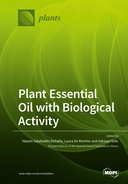Explore

Plant Essential Oil with Biological Activity
0 Ungluers have
Faved this Work
Login to Fave
Plant essential oils (PEOs) are hydrophobic liquids that contain volatile chemical components that are derived from various plant parts. They are among the most important plant natural products because of their diverse biological features as well as their therapeutic and nutritional applications. In addition, several aromatic PEOs are used to flavor food and add aromas to incense in the culinary sector. Recently, many PEOs have demonstrated promising antimicrobial activity against different post-harvest diseases and have been considered as possible natural alternatives for chemical treatments. This Special Issue titled “Plant Essential Oil with Biological Activity” provided an overview of several elements of PEOs, including their biological applications, antimicrobial activities, bio-pharmaceutical properties, principal single constituents, and mechanisms of action. This Special Issues fills in knowledge gaps and aids in the advancement of EO applications around the world. This issue contains thirteen research articles and two review papers that address a wide range of topics and applications relevant to the bioactivity of PEOs.
This book is included in DOAB.
Why read this book? Have your say.
You must be logged in to comment.
Rights Information
Are you the author or publisher of this work? If so, you can claim it as yours by registering as an Unglue.it rights holder.Downloads
This work has been downloaded 287 times via unglue.it ebook links.
- 287 - pdf (CC BY) at Unglue.it.
Keywords
- Aerva javanica
- agri-food industry
- allelopathy
- angustione
- Anisosciadium lanatum
- Annona cherimola
- anti-inflammation
- anti-senility
- antibacterial
- Antibacterial activity
- anticholinesterase activity
- antifungal activity
- antimicrobial
- antimicrobial activity
- antioxidant
- antioxidant activity
- antioxidant enzymes
- Antioxidants
- apoptotic markers
- aromatic plants
- Asteraceae
- BCL-2
- bioherbicides
- Biological control
- Campylobacter jejuni
- caspase-3
- cell membrane permeability
- chemical composition
- chemometric analysis
- chemotype
- Cleome genus
- Curcuma longa
- Cytotoxicity
- damage index
- eco-friendly product
- Ecuador
- enantiomers
- enantioselective analysis
- Environmental factors
- essential oil
- essential oils
- extraction methods
- Food preservatives
- fruit storage
- Fusarium root rot
- GC-MS
- germacrene D
- Green chemistry
- HepG2
- herbicidal
- Herbicides
- horseweed
- hydrodistillation
- Jungia bullata
- Jungia jelskii
- Jungia malvifolia
- Jungia rugosa
- Medicinal plants
- medicine
- Mentha longifolia GC–MS
- Mentha spicata
- Natural Products
- Oncosiphon suffruticosum
- Other branches of medicine
- pale smartweed
- Pharmacology
- phytopathogens
- phytotoxicity
- postharvest diseases
- Pulicaria crispa
- quality preservation
- quality-related attributes
- sandy soil
- seasonal variation
- sesquiterpenes
- sun protection factor
- terpenes
- tomato
- trichomes
- tyrosinase inhibition
- volatile oils
- volatiles
- wavy-leaf fleabane
- WRKY transcription factor
Links
DOI: 10.3390/books978-3-0365-3846-4Editions

